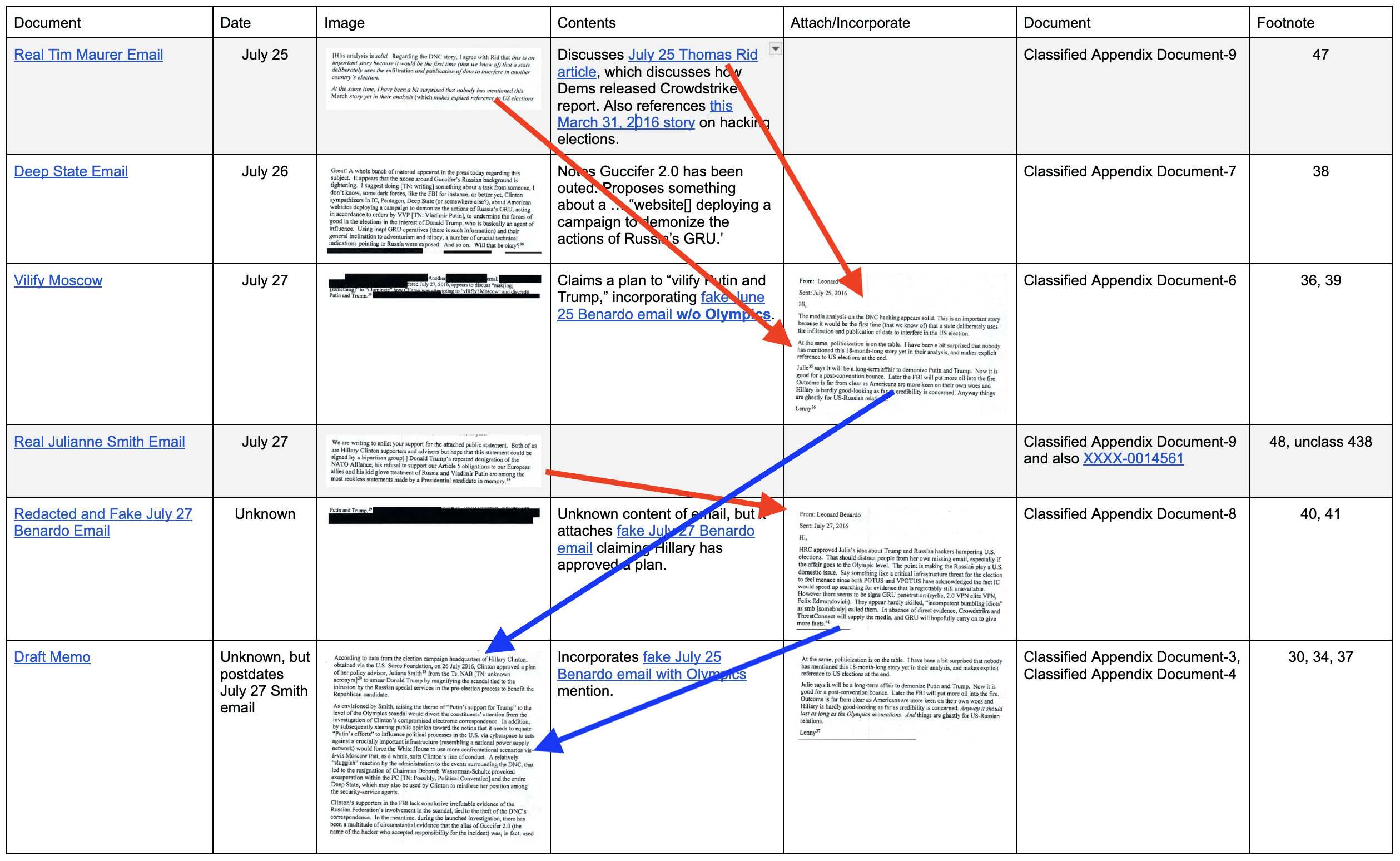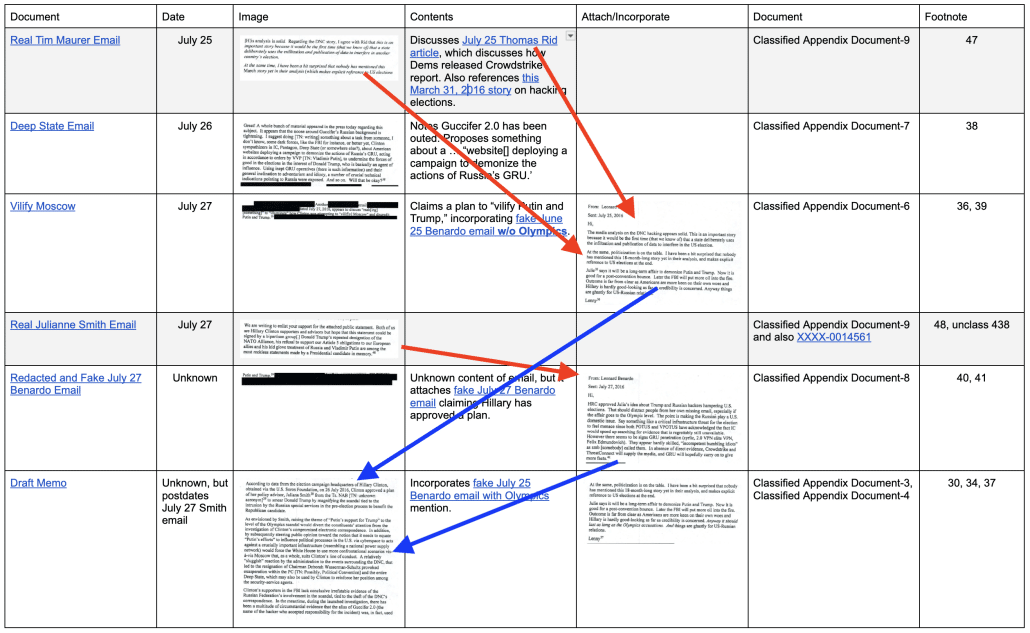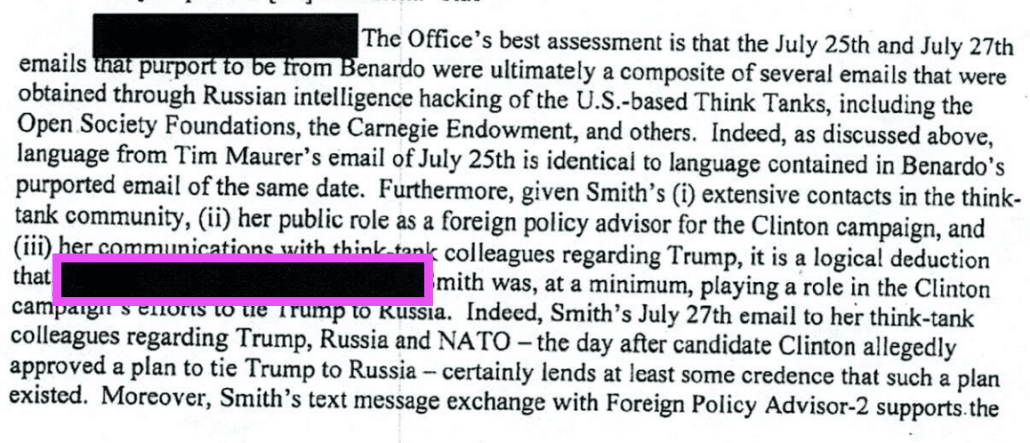How John Durham Buried Evidence He Had Been Doing the Work of Russian Spies … and then Tulsi Gabbard Buried More
As I’ve been showing, the Durham classified annex goes to significant lengths to hide that a Russian email discussing creating a conspiracy theory about the American Deep State, which he dates to July 26, precedes the draft SVR memo he claims has animated his years-long hunt, which dates to July 27 or later.
You can date the draft SVR memo (Durham doesn’t provide its date at all in the unclassified report, and if he does here, the date has been redacted) by tracking the inputs (red arrows) into the fake emails on which the draft memo is purportedly based (blue arrows), as I lay out here.
You can review a live copy of this (without the arrows) at this link.
The fake email integrated into the memo itself — bearing the date of July 25 but mentioning the Olympics — derives from the Thomas Rid story and the real Tim Maurer email — but it appears to have been altered to add the reference to the Olympics on July 27 (because a copy without the Olympics mention is attached to an email dated July 27).
And the fake email, bearing the date of July 27, claiming that Hillary approved a plan on July 26 appears to derive from the real July 27 Julianne Smith email soliciting a totally innocuous letter condemning Trump’s attack on NATO. We might learn more about its creation, except the email to which it is attached is entirely redacted in the annex.
That is, so long as his claim that the Deep State memo is dated “the day after” two emails purporting to be dated June 25 is accurate, then the emails and draft report that guided his entire investigation were the conspiracy theory proposed on July 26. Durham did the work of Russian spies for four years.
If this is, indeed, the timeline, then Durham — as well as John Ratcliffe and Kash Patel — should have recognized they were pursuing an investigation of Hillary Clinton based off a deliberate Russian spy hoax.
There’s one more thing that supports this argument — and reveals how problematic it is for Durham (who continued his investigation for two more years after he would have concluded the emails were “composites”) and the others: the extent to which he, as well as the person who redacted this for release, tried to obscure all this in the classified annex.
This kind of deceit was not remotely unusual for Durham (as I’ll return to when I review what Durham did do after concluding he was using a clear Russian hoax as his excuse to investigate Hillary Clinton). Andrew DeFilippis, especially, did this kind of stuff all the time. Here, where he used email timestamps in two different time zones to falsely suggest that Fusion was the source for a public link about the Alfa Bank anomalies, is just one such example.
The list below is overwhelming. The most important detail, however, is how Durham treats the real email from Julianne Smith asking people to sign onto some totally innocuous letter criticizing Trump’s attacks on NATO. Durham obtained one copy of the email from the SVR trove and another from a subpoena, presumably to Smith or CNAS, where she worked.
The annex separates the disclosure that Julianne Smith had also been hacked (noted in footnote 27) from the discussion of the email she sent on July 27, obscuring that Durham obtained two copies of that email, one from the SVR collection (cited in the annex as Document Classified Appendix Document 9, which also includes the Maurer email), and one via subpoena (cited in the unclassified report as XXXX-0014561). He does that even though discussion of the “certain emails, attachments, and documents that contain language and references with the exact same or similar verbiage to the materials referenced above” precedes that discussion. In the unclassified report, he treats this email differently, effectively treating it as corroboration for the claims in the fake report, rather than a source used to fabricate it (though he later uses it as corroboration after concluding that the underlying emails are composites based on … that email).
In either case, however, if he is treating Smith’s July 27 email as a source (and that’s one place it appears in his report), then the draft memo must post-date the July 26 Deep State email.
On July 26, Russian spies decided it’d be cool to start a conspiracy theory about the Deep State. And on July 27, having stolen that Smith email, they decided to claim that Hillary — as opposed to some other Deep State entity — decided to smear Donald Trump.
And everyone involved in this is working really hard to hide that they knew that.
Update: On the topic of Smith’s email, I’ve been puzzling over the redaction in this passage; I wondered if Durham expressed some obnoxious opinion about her.
It was suggested to me, however, that that redaction might hide Durham speculating about what Russian spooks thought — maybe something like, “it is a logical deduction that [Russian spies believed that]”… The mention of the spies would therefore justify classification on classification bases. But holy hell if it were something like that, it would mean Durham was trying to rationalize why Russian spooks fabricated emails to make up this claim.
Durham’s deceits
By July 2021, John Durham had evidence to conclude the emails behind a draft SVR memo on which his entire investigation rested were “composites,” that is, fabrications. But he continued on for two more years, attempting and failing to create evidence to substantiate that Russian disinformation by prosecuting Michael Sussmann and Igor Danchenko. To hide that he had done that, he engaged in a great deal of deceit in both his unclassified and classified reports.
- Durham frames his focus around three bullets John Ratcliffe included in his 2020 memo sending these materials to Lindsey Graham. The first bullet claims to focus on “Russian intelligence analysis,” suggesting that his focus was on a draft SVR report that leads the narrative in the classified appendix, but is actually the last document temporally. But the second bullet refers to John Brennan notes that quote not the purported end analysis, but an email advancing the plot to frame Hillary.
- The two exhibits — Brennan’s notes and a referral from the CIA that he couldn’t prove ever got sent to FBI — include redactions that obscure the actual content of both. Importantly, witnesses were not shown the full exhibits, though Brennan correctly stated that Durham misrepresented what his notes were about.
- Durham misrepresented how many witnesses (and who) testified that they had not seen the referral memo.
- Thereafter in the unclassified report, Durham referred to “Clinton Plan intelligence” as if it focused on that discreet claim or even the draft memo, when it referred to the larger body of intelligence obtained via the Dutch, and so in context the plan to frame Hillary. In the classified report, Durham referred to Clinton campaign plan, rather than the intelligence asserting it.
- Durham mentioned two Leonard Benardo emails early in the annex (there were actually four documents claiming to be emails in the report), then discussed the earlier, apparently finished, intelligence from earlier 2016 implicating Loretta Lynch, suggesting they were the emails. He returns to this strategy later in the appendix.
- Then, the beginning of the section focused on the SVR documents starts with the draft memo, not the specific emails. He keeps moving the ball.
- The date of the draft memo appears nowhere in the unclassified report and may not appear in the classified report either (if it is there, it is redacted).
- The annex separates the disclosure that Julianne Smith had also been hacked (noted in footnote 27) from the discussion of the email she sent on July 27, obscuring that Durham obtained two copies of that email, one from the SVR collection (cited in the annex as Document Classified Appendix Document 9, which also includes the Maurer email), and one via subpoena (cited in the unclassified report as XXXX-0014561). He does that even though discussion of the email appears after the introduction, “certain emails, attachments, and documents that contain language and references with the exact same or similar verbiage to the materials referenced above.” In the unclassified report, he treats this email differently, effectively treating it as corroboration for the claims in the fake email, rather than a source used to fabricate it (though he also uses it as corroboration after concluding that the underlying emails are composites based on … that email). In either case, however, if he is treating Smith’s July 27 email as a source, then the draft memo must post-date the July 26 Deep State email talking about ginning up a conspiracy theory.
- After introducing the Benardo emails, the annex discloses there were several versions of the July 25 one, which helps to obscure that one copy of the earliest version was attached to a July 27 email, which in turn suggests the reference to the Olympics was added on July 27. As noted, the redactions exacerbate this sleight of hand.
- The annex hides that the Deep State email predates the draft memo by discussing the two versions of the July 25 Benardo email in-between.
- The annex doesn’t appear to explain that one of two copies of the first fake July 25 email (without the Olympics) is considered part of the same document as the July 27 “vilify” email.
- The description that the real Tim Maurer email is the same date as the fake July 25 emails gives the impression that they were made the same day, when at least the revisions of the fake email probably happened on July 27.
- Durham provides a description of this (then-dated) article about a voting hacker for hire, but does not provide a description of the Thomas Rid article discussed in the email, which is not only a clear source for the draft memo, but should make analysts look twice at the Russian idiom in English in the fake Benardo email, because Rid discusses the language games behind the Guccifer 2.0 persona at some length.
- When Durham concedes the emails to which the draft memo is sourced are composites, he does not name CNAS, where Smith worked, even though earlier in the section he says she was hacked too.
Lying with redactions
- The introduction to the draft memo redacts details about what is in it, most notably the emails the entire annex purports to focus on.
- That continues in the redactions after the draft memo. This obscures which email was incorporated into the draft memo: the one referring to the Olympics. The redaction introducing the first fake July 25 email further obscures this, making it harder to figure out that Classified Appendix Document 6 is a July 27 email with one of the first versions of the July 25 email (that is, before the Olympics were added) attached.
- The redaction of the email after the July 27 “vilify” one obscures that the July 27 Benardo email discussing Hillary’s approval is attached to that redacted email and not the “vilify” one, further obscuring that the emails dated July 25 were likely revised on July 27, to add the Olympics reference.

















